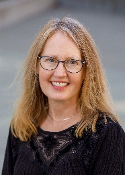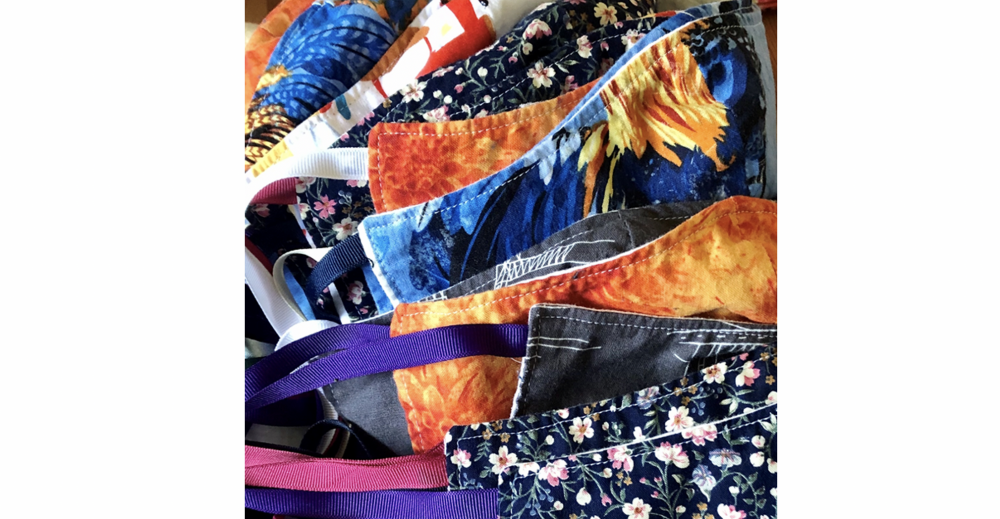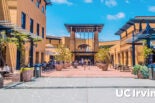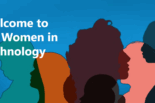By Yvonne Tevis. Colleen Gordon doesn’t sew—but early in the pandemic she co-founded a mask-making project that produced 6,000 home-sewn masks—masks that would go to neighbors, patients, the homeless, and anyone who needed one.
An IT project manager for UC Davis Health, Gordon and her UC colleagues were sent home in March 2020. “It was a very surreal moment,” she said. She remembers feeling helpless, and wanting to do something useful. On Facebook one day, she commented that maybe they could collect masks. Another woman responded by forming a Facebook group and assigning Gordon as a co-administrator.
A bit surprised, Gordon went along with it. “I’m good at coordinating,” she said. “And I like to talk to people.” She started by collecting N95 masks for the hospital. “We didn’t know if the hospitals were going to run out of PPE (personal protective equipment),” she explained. Pretty soon, people were dropping off bags stuffed with N95s at her house. An emergency room doctor and floor nurse she knew would swing by to collect them for colleagues to use as back up, if necessary.
The project simply ballooned from there, with over 1,000 people joining the Facebook group and signing up to help or to request masks. Subgroups were formed, not just to make masks but also to collect materials. For example, Gordon said, “The call went out, ‘Do you have any type of sewing supplies?’” Gordon herself started hunting down fabric and elastic, “because elastic sold out everywhere!” she said.
Ever inventive, the group started making masks with fabric ties instead of elastic. Assignments became specialized too, depending on people’s skills. One group only produced the fabric ties—cutting and ironing them—and then delivered them to sewers to incorporate into the final masks.
Group members also researched the best fabrics to block the virus (turns out it’s batik, due to the tight weave), worked with a doctor at Mercy Hospital in Sacramento to design a pattern, raised over $1,000 for supplies, got donated bolts of batik from JoAnn Fabrics, and even found professional fabric cutters who had the industrial machinery to cut massive amounts of fabric.
The group created kits, for those sewers who wanted them, or gave other sewers the raw materials to create their own. And people sewed masks. “It was like this mask movement that went crazy. All these sewers that were home and suddenly had a need to come to the forefront of COVID,” Gordon said. Her front porch became distribution central, with people dropping off quantities of supplies and sewn masks, and other people coming by to collect finished masks.
“It was all word of mouth,” she said. Organizations contacted her group for masks. Homeless advocates stopped by. The Department of Corrections requested masks for prisoners. Health care practitioners took masks to have on hand in case they ran out of N95s. People wanted masks for residents of nursing homes.
Then Gordon read a news story that broke her heart. The Navajo Nation was being hit hard by COVID, but members lacked PPE and ready access to health care. She thought, “I’m doing this mask-making project. There’s no reason why I can’t collect masks for them.” She put out the call, “Who wants to sew for the Navajo Nation?” Eight people joined her and—project manager that she is—she set a quota and gave them a month.
In the meantime, remembering a wonderful family trip to Antelope Canyon the year before, she reached out to a Navajo Nation tour operator, which put her in touch with Cindy, the canyon guide from her trip. Cindy was thrilled with the offer of masks and, being well connected in her community, was in a good position to accept and distribute them.
Gordon’s team met its goals and mid-May shipped a load of masks to Cindy, who tweeted: “640 Face Mask has arrived from Sacramento, California! Now, to distribute to Coppermine, LeChee, Gap, Kaibeto, and Tonalea plus anyone else that needs face mask. Once again, big THANK YOU to Colleen Gordon and friends.”
For Gordon, collecting masks for the Navajo Nation was the highlight of her mask-making endeavor. Not long afterwards, months into the pandemic, large companies had ramped up mask production and the need for the home sewers diminished. Reflecting on the project, she said it was a powerful thing to see people’s outpouring of willingness to give. “So many people felt so helpless at home. And I think it gave those sewers a mission. And boy-oh-boy did they fire up their sewing machines. It made people feel good.”
 Yvonne Tevis is editor, UC IT Blog, and chief of staff, Information Technology Services, University of California Office of the President.
Yvonne Tevis is editor, UC IT Blog, and chief of staff, Information Technology Services, University of California Office of the President.









So proud of you colleen
So important! Thank you for the story. Inspiring!